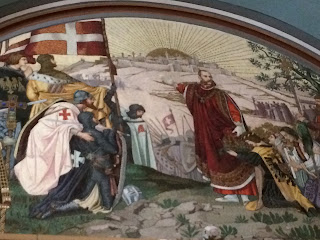The Austrian Pilgrims' Hospice, strategically placed in the Muslim Quarter at the junction of the Via Dolorosa and El Wad Street (HaGai), is one of my favourite places to visit while touring the old city.
 |
| Austrian Hospice in the 19th Century |
The Austrian Hospice is one of a number of historical buildings erected by European powers towards the end of the 19th century as the 400-year Ottoman rule was coming to a close.
After the foundation stone was laid on New Year's Eve 1856 the Hospice became one of the city's leading ecclesiastical guesthouses before being taken over by other parties. It served as an orphanage, internment camp, officers' school and military hospital. In 1985, with assistance from Jerusalem Mayor Teddy Kollek, the building was returned to its original function and is currently run by local and Austrian staff and volunteers.
One of its most famous guests was Kaiser Franz Josef who stayed here in 1869 on his way to the opening of the Suez Canal. In addition to being Emperor of Austria, King of Hungary and monarch of other states in the Austro-Hungarian Empire, he also took the title of "King of Jerusalem".
A mosaic in the charming chapel depicts him pointing the way to the Holy City leading his new Crusade.
Built in the style of Vienna's Ringstrasse palaces of the 19th century, the pilgrims' hospice is a wonderful place to enjoy a coffee and strudel in the Viennese Cafe or sip a beer in the well-tended gardens.
 |
| View from the roof |
The Austrian Hospice offers an oasis of tranquility in the old city and affords a wonderful panoramic view from its rooftop. Ring the doorbell to leave the Middle Eastern bazaar and enter the grandeur of the House of Habsburg - a real Jerusalem secret!
There is a fee of 5 shekels to visit the rooftop panorama.







